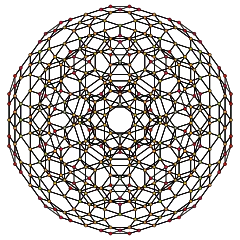Pentagonal prism
In geometry, the pentagonal prism is a prism with a pentagonal base. It is a type of heptahedron with 7 faces, 15 edges, and 10 vertices.
| Uniform pentagonal prism | |
|---|---|
 | |
| Type | Prismatic uniform polyhedron |
| Elements | F = 7, E = 15 V = 10 (χ = 2) |
| Faces by sides | 5{4}+2{5} |
| Schläfli symbol | t{2,5} or {5}×{} |
| Wythoff symbol | 2 |
| Coxeter diagram | |
| Symmetry group | D5h, [5,2], (*522), order 20 |
| Rotation group | D5, [5,2]+, (522), order 10 |
| References | U76(c) |
| Dual | Pentagonal dipyramid |
| Properties | convex |
 Vertex figure 4.4.5 | |

As a semiregular (or uniform) polyhedron
If faces are all regular, the pentagonal prism is a semiregular polyhedron, more generally, a uniform polyhedron, and the third in an infinite set of prisms formed by square sides and two regular polygon caps. It can be seen as a truncated pentagonal hosohedron, represented by Schläfli symbol t{2,5}. Alternately it can be seen as the Cartesian product of a regular pentagon and a line segment, and represented by the product {5}x{}. The dual of a pentagonal prism is a pentagonal bipyramid.
The symmetry group of a right pentagonal prism is D5h of order 20. The rotation group is D5 of order 10.
Volume
The volume, as for all prisms, is the product of the area of the pentagonal base times the height or distance along any edge perpendicular to the base. For a uniform pentagonal prism with edges h the formula is
Use
Nonuniform pentagonal prisms called pentaprisms are also used in optics to rotate an image through a right angle without changing its chirality.
In 4-polytopes
It exists as cells of four nonprismatic uniform 4-polytopes in 4 dimensions:
| cantellated 600-cell |
cantitruncated 600-cell |
runcinated 600-cell |
runcitruncated 600-cell |
 |
 |
 |
 |
Related polyhedra
 The pentagonal stephanoid has pentagonal dihedral symmetry and has the same vertices as the uniform pentagonal prism.
The pentagonal stephanoid has pentagonal dihedral symmetry and has the same vertices as the uniform pentagonal prism.
| Family of uniform prisms | |||||||||||
|---|---|---|---|---|---|---|---|---|---|---|---|
| Polyhedron | |||||||||||
| Coxeter | |||||||||||
| Tiling | |||||||||||
| Config. | 2.4.4 | 3.4.4 | 4.4.4 | 5.4.4 | 6.4.4 | 7.4.4 | 8.4.4 | 9.4.4 | 10.4.4 | 11.4.4 | 12.4.4 |
External links
- Weisstein, Eric W. "Pentagonal prism". MathWorld.
- Pentagonal Prism Polyhedron Model -- works in your web browser